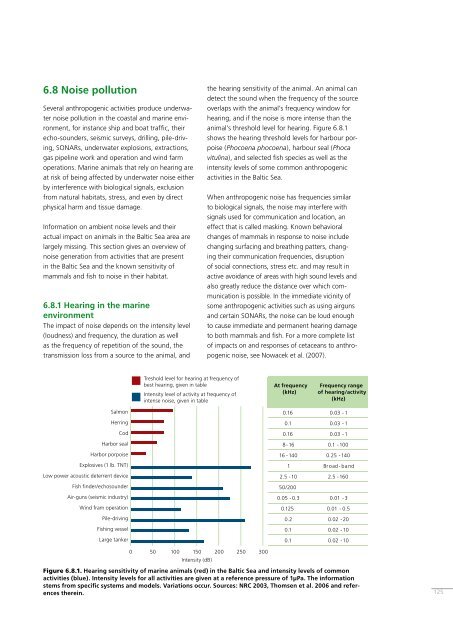BSEP116B Biodiversity in the Baltic Sea - Helcom
BSEP116B Biodiversity in the Baltic Sea - Helcom
BSEP116B Biodiversity in the Baltic Sea - Helcom
You also want an ePaper? Increase the reach of your titles
YUMPU automatically turns print PDFs into web optimized ePapers that Google loves.
6.8 Noise pollution<br />
Several anthropogenic activities produce underwater<br />
noise pollution <strong>in</strong> <strong>the</strong> coastal and mar<strong>in</strong>e environment,<br />
for <strong>in</strong>stance ship and boat traffic, <strong>the</strong>ir<br />
echo-sounders, seismic surveys, drill<strong>in</strong>g, pile-driv<strong>in</strong>g,<br />
SONARs, underwater explosions, extractions,<br />
gas pipel<strong>in</strong>e work and operation and w<strong>in</strong>d farm<br />
operations. Mar<strong>in</strong>e animals that rely on hear<strong>in</strong>g are<br />
at risk of be<strong>in</strong>g affected by underwater noise ei<strong>the</strong>r<br />
by <strong>in</strong>terference with biological signals, exclusion<br />
from natural habitats, stress, and even by direct<br />
physical harm and tissue damage.<br />
Information on ambient noise levels and <strong>the</strong>ir<br />
actual impact on animals <strong>in</strong> <strong>the</strong> <strong>Baltic</strong> <strong>Sea</strong> area are<br />
largely miss<strong>in</strong>g. This section gives an overview of<br />
noise generation from activities that are present<br />
<strong>in</strong> <strong>the</strong> <strong>Baltic</strong> <strong>Sea</strong> and <strong>the</strong> known sensitivity of<br />
mammals and fish to noise <strong>in</strong> <strong>the</strong>ir habitat.<br />
6.8.1 Hear<strong>in</strong>g <strong>in</strong> <strong>the</strong> mar<strong>in</strong>e<br />
environment<br />
The impact of noise depends on <strong>the</strong> <strong>in</strong>tensity level<br />
(loudness) and frequency, <strong>the</strong> duration as well<br />
as <strong>the</strong> frequency of repetition of <strong>the</strong> sound, <strong>the</strong><br />
transmission loss from a source to <strong>the</strong> animal, and<br />
<strong>the</strong> hear<strong>in</strong>g sensitivity of <strong>the</strong> animal. An animal can<br />
detect <strong>the</strong> sound when <strong>the</strong> frequency of <strong>the</strong> source<br />
overlaps with <strong>the</strong> animal’s frequency w<strong>in</strong>dow for<br />
hear<strong>in</strong>g, and if <strong>the</strong> noise is more <strong>in</strong>tense than <strong>the</strong><br />
animal’s threshold level for hear<strong>in</strong>g. Figure 6.8.1<br />
shows <strong>the</strong> hear<strong>in</strong>g threshold levels for harbour porpoise<br />
(Phocoena phocoena), harbour seal (Phoca<br />
vitul<strong>in</strong>a), and selected fish species as well as <strong>the</strong><br />
<strong>in</strong>tensity levels of some common anthropogenic<br />
activities <strong>in</strong> <strong>the</strong> <strong>Baltic</strong> <strong>Sea</strong>.<br />
When anthropogenic noise has frequencies similar<br />
to biological signals, <strong>the</strong> noise may <strong>in</strong>terfere with<br />
signals used for communication and location, an<br />
effect that is called mask<strong>in</strong>g. Known behavioral<br />
changes of mammals <strong>in</strong> response to noise <strong>in</strong>clude<br />
chang<strong>in</strong>g surfac<strong>in</strong>g and breath<strong>in</strong>g patters, chang<strong>in</strong>g<br />
<strong>the</strong>ir communication frequencies, disruption<br />
of social connections, stress etc. and may result <strong>in</strong><br />
active avoidance of areas with high sound levels and<br />
also greatly reduce <strong>the</strong> distance over which communication<br />
is possible. In <strong>the</strong> immediate vic<strong>in</strong>ity of<br />
some anthropogenic activities such as us<strong>in</strong>g airguns<br />
and certa<strong>in</strong> SONARs, <strong>the</strong> noise can be loud enough<br />
to cause immediate and permanent hear<strong>in</strong>g damage<br />
to both mammals and fish. For a more complete list<br />
of impacts on and responses of cetaceans to anthropogenic<br />
noise, see Nowacek et al. (2007).<br />
Treshold level for hear<strong>in</strong>g at frequency of<br />
best hear<strong>in</strong>g, given <strong>in</strong> table<br />
Intensity level of activity at frequency of<br />
<strong>in</strong>tense noise, given <strong>in</strong> table<br />
At frequency<br />
(kHz)<br />
Frequency range<br />
of hear<strong>in</strong>g/activity<br />
(kHz)<br />
Salmon<br />
Herr<strong>in</strong>g<br />
Cod<br />
Harbor seal<br />
Harbor porpoise<br />
Explosives (1 lb. TNT)<br />
Low power acoustic deterrent device<br />
Fish f<strong>in</strong>der/echosounder<br />
Air-guns (seismic <strong>in</strong>dustry)<br />
W<strong>in</strong>d fram operation<br />
Pile-driv<strong>in</strong>g<br />
Fish<strong>in</strong>g vessel<br />
Large tanker<br />
0.16 0.03 - 1<br />
0.1 0.03 - 1<br />
0.16 0.03 - 1<br />
8-16 0.1 -100<br />
16-140 0.25 -140<br />
1 Broad-band<br />
2.5 - 10 2.5 - 160<br />
50/200<br />
0.05 -0.3 0.01 -3<br />
0.125 0.01 - 0.5<br />
0.2 0.02 - 20<br />
0.1 0.02 - 10<br />
0.1 0.02 - 10<br />
0 50 100 150 200 250 300<br />
Intensity (dB)<br />
Figure 6.8.1. Hear<strong>in</strong>g sensitivity of mar<strong>in</strong>e animals (red) <strong>in</strong> <strong>the</strong> <strong>Baltic</strong> <strong>Sea</strong> and <strong>in</strong>tensity levels of common<br />
activities (blue). Intensity levels for all activities are given at a reference pressure of 1µPa. The <strong>in</strong>formation<br />
stems from specific systems and models. Variations occur. Sources: NRC 2003, Thomsen et al. 2006 and references<br />
<strong>the</strong>re<strong>in</strong>.<br />
125

















